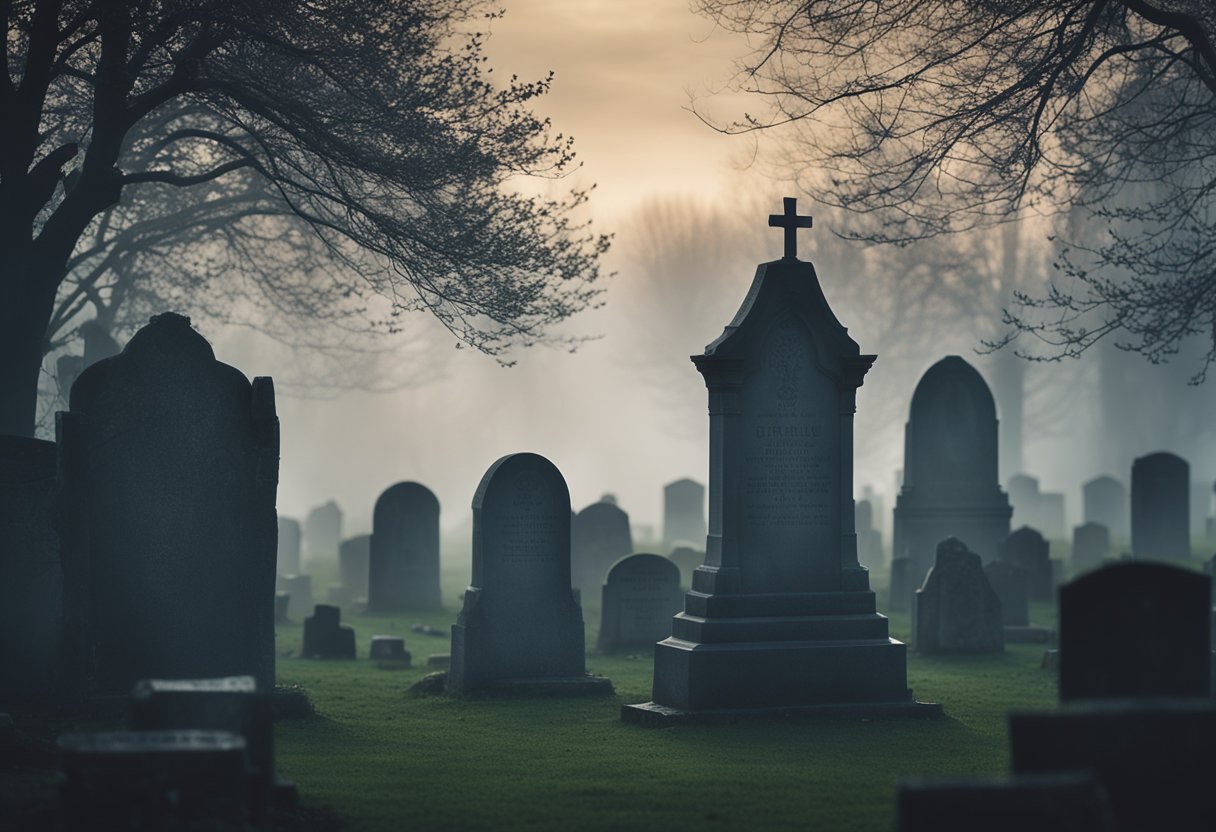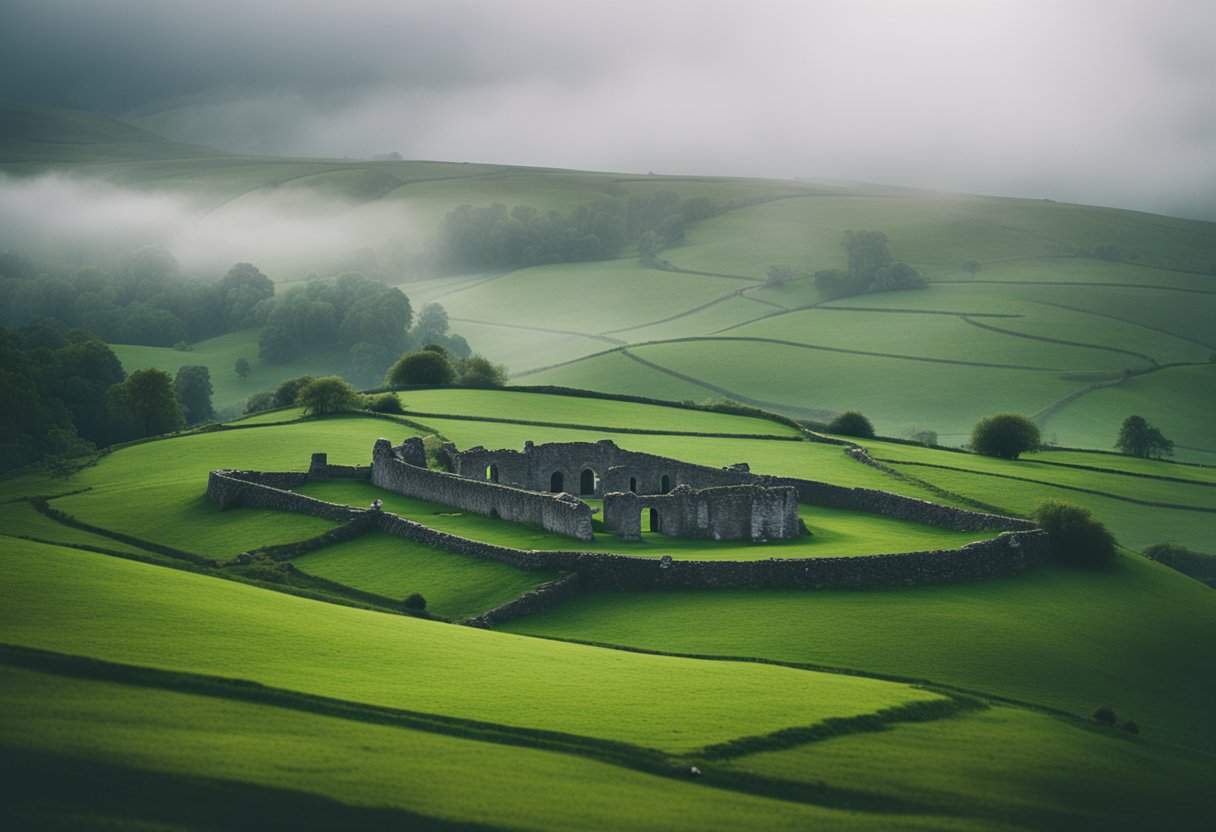Banshee Encounters: The Irish Death Messenger Unveiled

Updated On: April 24, 2024 by Maha Yassin
The banshee’s wail, a harbinger of death unique to Irish folklore, has fascinated and chilled people’s hearts for centuries. As the spectral messenger, the banshee reputedly appears to forewarn of an impending demise within a family, her cries echoing through the Celtic twilight. This tradition, deeply woven into the rich tapestry of Ireland’s history, persists through tales passed down from generation to generation. Irish death messengers such as the banshee reveal much about the nation’s attitudes towards death and the supernatural and underscore the cultural importance of preserving these stories.
Personal accounts of encounters with the banshee offer a vivid window into a belief system that has been an integral part of Irish heritage. Though typically depicted as an omen of misfortune, the banshee’s role in Irish lore has varied nuances that have evolved through the years. The stories of her appearances, her anguished cries, and her prophetic significance continue to intrigue the Irish and those of Irish descent worldwide. Our exploration of these personal tales presents a catalogue of experiences that delve into this spectral figure’s profound impact on those who claim to have witnessed her presence.
Historical Origins of the Banshee: Irish Death Messenger
Embarking on a journey through the annals of Irish legend, we uncover the evolution of the Banshee from a mere myth to a harbinger of mortality.
From Fairy to Messenger
The Banshee, known in Old Irish as ‘Bean Sídhe,’ which translates to ‘woman of the fairy mounds,’ began as a supernatural entity associated with the pre-Christian deities of Irish mythology. She is often considered a sign of transition, her existence tethered to the Irish tradition where women would sing a lament at funerals, known as ‘keening’. This practice has, over time, become intrinsically linked with the banshee’s mournful cry, believed to foretell the passing of a family member.
Literary and Documentary Sources
Literary sources trace the banshee’s narrative back to the medieval times within the richest veins of Irish folklore. As folklore scholars scoured through oral and documentary sources, they unearthed numerous accounts and tales that solidified the banshee’s role in Irish culture. The earliest writings, found in annals and folklore compilations, provide us with a glimpse into the beliefs surrounding this wailing spirit, illustrating the banshee’s longstanding position within Irish heritage.
Characteristics and Depictions
In our delve into the haunting figure of the Banshee, we’ll focus on the distinct characteristics that mark her presence and how she’s represented in Irish literary works.
Visual and Aural Features
The Irish death messenger is often envisioned as a spectral figure cloaked in traits that are as eerie as they are specific. Visually, she may appear as a forlorn woman, cloaked in rags, with long, flowing hair that they sometimes comb with a silver or golden comb. This visual is not fixed, however, as some accounts describe her as a stunning young maiden while others see her as a grave old crone. The Banshee’s hair, whether wild and unkempt or smooth and neat, remains a profound emblem of her ghostly image.
Audibly, the Banshee is known for her piercing wail, a sorrowful keen that is said to foretell the death of a family member. This keening is a lament, historically performed in Ireland by mourning women. When heard, the Banshee’s cry cuts through the stillness of the night, unmistakable and laden with impending doom.
Representation in Irish Literature
In Irish literature, the Banshee has been immortalised with a rich tapestry of narratives that showcase her role as the harbinger of death. She takes her place in folklore and poems, etched into the psyche of Irish culture with each passing tale. For example, in W.B. Yeats’ works, the Banshee’s presence looms as a figure of Irish mysticism and supernatural influence, sharing connections to family dynasties and the otherworld. Other literary pieces engage more directly with Banshee’s visage, noting her pale face, sometimes framed by locks of red or grey, an ever-present reminder of the mortality that bounds all within the Irish landscape.
Banshee Encounters Across Ireland
The eerie wails of the Irish death messenger are deeply embedded in Irish folklore, manifesting in diverse forms peculiar to regions across Ireland. The tales of these encounters are both harrowing and fascinating, forming an integral part of our cultural narrative.
Regional Variations
In our exploration of the Emerald Isle, we’ve heard distinct variations of the Banshee lore, reflecting Ireland’s rich tapestry of regional folklore. Ulster tales speak of a banshee with a ghastly wailing that chills to the bone, often heard near ancient castles and family estates. In comparison, Munster legends recount encounters with a quieter yet sorrowful Banshee, lamenting with soft cries that carry on the wind.
| Region | Description of Banshee |
|---|---|
| Ulster | A loud, bone-chilling wail |
| Munster | A softer, sorrowful cry |
Personal Accounts and Tales
Our collective is replete with personal anecdotes and narratives of Banshee encounters. A chilling case comes from a small village in Connacht, where a family reports having heard the haunting laments of the Banshee the night before discovering one of their beloved elders had passed. Meanwhile, in Leinster, there are recollections of a silent Banshee, seen combing her hair diligently near the riverside, her presence a foreboding omen rather than an audible warning.
- Connacht Tale:
- The family heard haunting laments before a death.
- Leinster Account:
- A silent Banshee sighting foreshadowed an impending departure.
Cultural and Mythological Analysis
Before delving into specific cases of banshee encounters, it is crucial to understand the creature’s place within Irish mythology and how it has been examined through comparative folklore.
Role in Irish Mythology
The banshee has profound roots in Irish tradition and is viewed as a supernatural being and an integral part of the family history. The wailing of a banshee is traditionally understood as an omen foretelling the imminent death of a family member. In Irish culture, she is connected to particular families, and it is often believed that the banshee laments for the death out of a familial bond formed over generations.
Comparative Folklore Studies
Insights from Scandinavian scholars offer a unique perspective, revealing that similar entities exist within other cultures, pointing to a broader mythological archetype. For example, elements of the banshee can be compared to figures like the Nordic fylgja, which also follow specific families and indicate forthcoming deaths. However, our analysis reveals that the banshee’s portrayal in Irish folklore is distinct in its emotional connection to heritage and the collective memory of those who believe in its presence.
Contemporary Beliefs and Attitudes
In exploring beliefs about the banshee, it’s clear that attitudes have progressed from traditional superstitions to more nuanced understandings in our community.
From Superstition to Modern Viewpoints
Superstitions regarding the banshee have undeniably altered over time. Historically, the banshee was firmly entrenched in Irish folklore as a harbinger of death. Today, however, we find that the belief in the banshee is often perceived with a blend of scepticism and cultural appreciation. While fewer people may hold a literal belief in the banshee as a supernatural entity foretelling death, the figure remains a potent symbol within Irish heritage. Discussions about the banshee now often centre on its cultural significance rather than its presence as a physical manifestation.
Banshee’s Relevance in Present Day
The relevance of the banshee in present-day Ireland lies in its representation of a community’s connection to its past. While most of us no longer hold to the beliefs in their original form, the stories of the banshee continue to be shared and adapted, capturing the imagination of new generations. They serve as a touchstone for our societal attitudes toward death, the supernatural, and cultural identity. How these tales have changed reflects broader attitudes within the Irish community, illustrating a move away from fear and towards a more reflective perspective on our folklore and traditions.
Academic Perspectives on the Irish death messenger
The academic viewpoint on the Banshee is often a tapestry of intensive research and cross-disciplinary analysis, elucidating a phenomenon deeply rooted in Irish folklore.
Patricia Lysaght’s Contributions
An esteemed folklorist, Patricia Lysaght, has significantly contributed to our understanding of the Banshee. Her extensive work is especially apparent in her PhD thesis, which meticulously examines the Banshee’s place within the Irish tradition. Lysaght’s research has been pivotal in authenticating the various aspects of Banshee encounters relating to familial folklore and regional variance across Ireland. Her scholarly approach provides a lucid dissection of how these apparitions are integrated into Irish societal norms and mortuary customs.
Scientific Analyses and Theses
In scientific analysis, the Banshee is often subject to varied interpretations. Academics analyse historical accounts and local narratives to shape a more empirical understanding of these phenomena. Thesis works diligently to inquire into the Banshee’s symbolism, dissecting the layers of folklore to arrive at the underpinnings of psychological, sociological, and cultural significance. Through scientific methodology, the authenticity of experiences and the implications of the Banshee figure in Irish life are scrutinised. This analysis aids in drawing connections between reported sightings and the collective psyche of communities.
The Irish Death Messenger in Popular Culture
In popular culture, the banshee has transcended its original Irish folklore to become an entity known worldwide, influencing various media and entertainment genres.
Media Interpretations
Originally a foreboding figure from Irish folklore, the banshee has been widely represented in popular media, often with heightened drama to captivate audiences. Films and television series within the horror and fantasy genres frequently feature the banshee, sometimes adhering to the traditional portrayal of a wailing spirit signalling imminent death and, at other times, reimagining her with creative liberties. For example, American and Scandinavian productions have depicted the banshee as everything from a malevolent ghost to a misunderstood harbinger.
Literary interpretations, particularly within English literature, often delve into the more nuanced aspects of the banshee legend. Whether the focus is on the terror she induces or the sympathy she evokes due to her tragic origins, the banshee remains a figure of fascination and inspiration for authors and readers alike.
Banshee’s Influence on Entertainment
The banshee’s influence extends beyond visual media into the broader realm of entertainment, including music, literature, and video games. The spectral figure of the banshee has inspired song lyrics, and band names and has even been woven into the narratives of interactive gaming experiences. These interpretations can range from the deeply respectful and traditional to the innovative, blending Irish motifs with various cultural elements.
Moreover, the popularity of the banshee in entertainment media has led to cross-cultural adaptations of the myth. The intermingling of Irish folklore with other traditions has produced intriguing new stories and character arcs that reflect this global exchange of folklore.
Language and the Banshee
In studying the banshee, language plays a crucial role in describing this ethereal figure and in how it reflects the evolution of Irish culture and mythology.
Terminology Evolution
The term “banshee” has its origins in Old Irish, evolving from the words “bean sídhe” which translates to “woman of the fairy mounds.” Over the centuries, the name has been anglicised to the now more commonly known “banshee.” Old Irish, a language spoken from the 6th to the 10th century, has been pivotal in preserving the legends of the banshee through various literary sources that have shaped our modern interpretation of the ghostly figure.
Irish Language and the Creature’s Name
The Irish language contributes significantly to our understanding of the banshee. In Irish folklore, the banshee is known as “Bean Sí“, which directly translates to “fairy woman.” Drawing deeply from Irish linguistic roots, this title emphasises the banshee’s association with the supernatural elements of Irish mythology. The use of the Irish language in naming this creature anchors it firmly within the cultural context and provides depth to the ghost narrative in Ireland.
Publishing History of Banshee Folklore
Banshee folklore has a rich publishing history featuring numerous key works and scholarly reviews. Our exploration reveals the depth and breadth of literature on this iconic figure of Irish mythology.
Key Works and Editions
The O’Brien Press, a prominent Irish publisher, has been at the forefront of bringing banshee lore to readers, with several works exploring the mythical creature’s presence in Irish culture. Key titles include “The Banshee: The Irish Death Messenger”, providing stories and historical context on the banshee’s integration into Irish life. Esteemed authors have contributed significant scholarly work to this field, one being Patricia Lysaght with her comprehensive examination in “The Banshee: The Irish Supernatural Death Messenger”. These texts often come with an ISBN for easy cataloguing and reference in academic circles.
Reviews and Reception
The reception of banshee folklore publications has generally been positive, with reviews highlighting the careful balance authors strike between entertaining storytelling and academic rigour. Critics often commend the blend of personal anecdotes and historical research, which provides a multifaceted view of the banshee legend. These works are frequently reviewed in literary and cultural journals, where their contribution to preserving Irish heritage is recognised and appreciated.
Publications delving into the banshee mythos continue to enchant and inform Irish audiences and those with an avid interest in supernatural folklore worldwide.
Cartographical Showcase of Banshee Lore
As we explore the Banshee’s presence across Ireland, we create a composite picture that merges myth with place, offering a cartographical perspective on the sightings and stories.
Mapping the Tales
Delving into banshee encounters involves more than recounting eerie anecdotes; it requires cartographical precision. We’ve charted out various regions of Ireland where tales of the banshee have surfaced, constructing a detailed map highlighting notable locations with a history of sightings. This approach allows us to visualise the distribution of banshee lore across Ireland. From the West’s rugged coastlines to the Midlands’ misty fields, each pinpoint on our map tells a distinct story steeped in local tradition.
- Co. Kerry: Keening sounds near ancient ruins
- Co. Clare: Frequent appearances along the Cliff of Moher
- Co. Galway: Tales from the Aran Islands and their strong folklore
Geographic Spread and Local Legends
The geographic spread of banshee lore is as diverse as Ireland’s landscapes. Each location boasts its version of the legend, with variations reflecting local cultures and histories. In certain families, particularly those with a surname that starts with “O” or “Mac,” the connection to the banshee is especially profound. These families often possess personal anecdotes of encounters passed down through generations.
Highlighted Locales:
- Ulster: Known for tales where the banshee’s presence is seen as an omen of death.
- Munster: Here, legends often depict the banshee as a protective force.
- Connacht: Local lore includes banshees who foretell death but also offer comfort.
Italicised local names indicate a significant number of recorded apparitions. The banshee remains an integral part of Irish folklore, and our map serves as a living testament to its enduring presence across the island.
The Banshee Abroad

The haunting tales of the Banshee have travelled far beyond Ireland’s shores, carried by waves of emigrants and captivating foreign audiences with eerie fascination.
Irish Diaspora and the Spread of the Legend
From the 19th century onwards, the Irish diaspora has played a pivotal role in transplanting the legend of the Banshee across the globe. In 1982, stories of the Banshee’s mournful cries echoed in the Irish communities nestled into new homelands, stirring the same profound emotions in those of Irish descent as they did back home. This migration has transformed the Banshee from a uniquely Irish harbinger of death to a more universally recognised spectral phenomenon.
Global Perspectives on the Death Messenger
By 1996, the Banshee, much like other elements of Irish tradition, had been filtered through the lens of a global audience. Varied interpretations emerged, some aligning closely with the original Irish folklore, others adapting the figure to fit different cultural contexts. However, the core idea of a death messenger remained intact, underscoring the universality of dealing with loss and the appeal of a mythical figure that presages it.

Frequently Asked Questions
In this section, we address some of the most common questions surrounding the mysterious figure of the banshee in Irish folklore.
What occurs during a banshee sighting?
During a banshee sighting, individuals typically report seeing an apparition, often described as a woman dressed in white or grey, sometimes shrouded in a veil. This appearance is frequently accompanied by a lamenting cry or wail, which is said to be a harbinger of death approaching a member of the family observed.
Can the presence of a banshee foretell death?
Yes, according to Irish lore, the presence of a banshee is believed to signal the imminent death of a family member. The wailing or keening is said only to be heard by the family for whom the forewarning is meant.
What are the common characteristics of a banshee as per Irish traditions?
A banshee is traditionally understood to possess a piercing wail and often appears as a sad woman. Characteristics may vary regionally, but she is frequently seen with long, flowing hair and pale skin, reflective of the ghostly nature associated with her presence.
How should one react upon encountering a banshee?
When encountering a banshee, traditional beliefs suggest that one should respect the spectre and prepare for the potential loss within the family. As an omen foretelling death, the banshee’s visit requires serious contemplation rather than fear or attempts to interact with the apparition.
What is the historical significance of banshees in Irish culture?
Banshees hold a significant place in Irish culture as supernatural death messengers, rooted in a tradition dating back to the 8th century. Their lore is intertwined with Irish history, reflecting societal views on death, family, and the supernatural.
In what form does a banshee usually appear?
A banshee usually appears as a woman, varying in age depending on the telling. She can manifest as a young maiden, indicating an untimely death or an old crone, symbolising a more natural passing. The incarnation can also differ regionally throughout Ireland.






